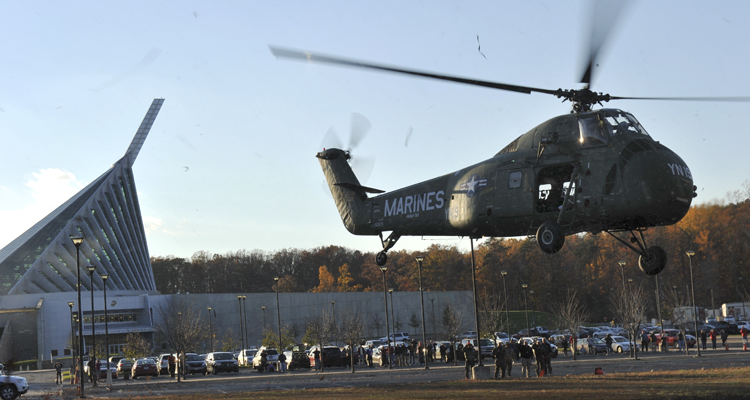![Veterans of HMM-361 pose with the restored Sikorsky UH-34D they presented to the National Museum of the Marine Corps. [U.S. Marine Corps]](https://www.historynet.com/wp-content/uploads/image/2012/AVH/dog_brief.jpg)
The Sikorsky UH-34D was properly named the Seahorse when flown by Marines, but jarheads usually called it the Dog. Nothing derogatory, for the Marines loved them—just a phonetic reference to its mark. This radial-engine helo with its unmistakable Shar Pei nose was first sent to Vietnam in 1963, when the Huey was still too underpowered and short-legged to be effective, and Marine Air, as usual, was left to fly other services’ castoffs.
Dogs were mainly used as troop transports and medevac birds, their only armament an M60 machine gun mounted in the left-door opening and fired by the aircraft’s crew chief. But a few were converted to gunships, called Stingers, with multi-rocket pods mounted to both landing-gear legs, each with a fixed, forward-firing M60 atop it, plus three more flexible M60s firing from the troop compartment.
UH-34D BuNo 150570 did brief service as a Stinger while it served in-country from July 1963 until July 1969. It flew in a number of HMM (Helicopter Medium Marine) squadrons and participated in Operations Shufly and Starlite—both important chapters in Marine Air’s Vietnam participation. Shufly was the first USMC involvement in Vietnam, when UH-34Ds flew support and recon missions for the Army of the Republic of Vietnam while U.S. personnel were still limited to being “advisers.” Starlite was the first major battle between U.S. forces and the Viet Cong, though it ended in something of a draw.
Five-seventy went to the Davis-Monthan storage depot in 1972 and was eventually bought by an Arizona helo operator. In 2001 the Marine Helicopter Squadron 361 Veterans Association acquired the hulk—it had served with HMM-361 with the Modex number YN-19 on its nose—and put 5½ years, 20,000 man-hours and $350,000 into restoring it to flight status. The vets flew it in airshows until the $1,500-an-hour cost became unsustainable. Their decision: donate it to the National Museum of the Marine Corps as one of the last Seahorses with a verifiable combat history. On November 8, 2013, they delivered it to Marine Corps Base Quantico. The next day, YN-19 made its final flight—a short hop across the base to the restoration shop for paint and interior touch-ups before going on display as part of the museum’s special Operation Starlite exhibition in 2016.





